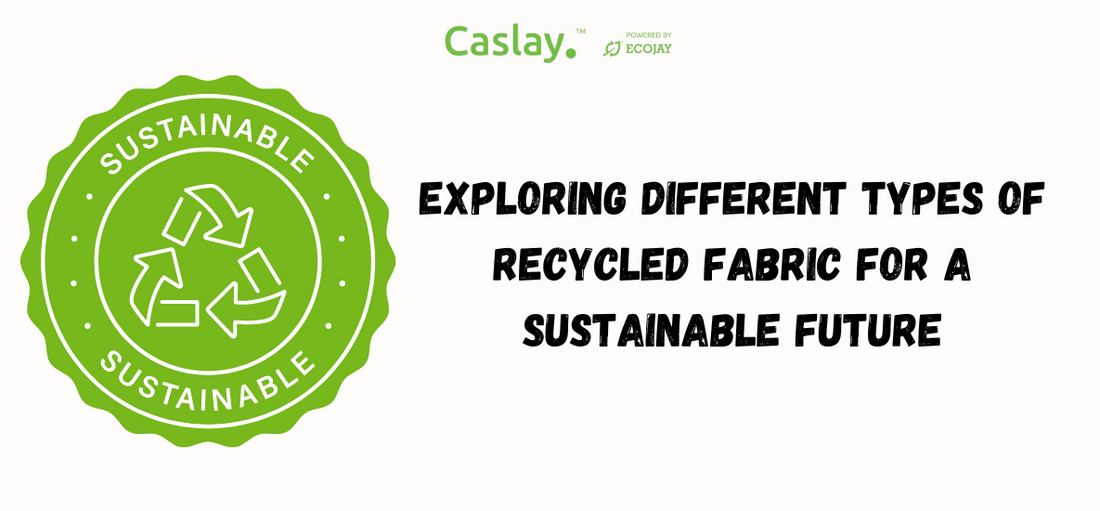
Exploring Different Types of Recycled Fabric for a Sustainable Future
Share
In the quest for sustainability, the textile industry has turned its focus to recycled fabrics, offering a solution to the environmental challenges posed by traditional textile production. Recycled fabrics not only reduce waste but also conserve resources and decrease pollution. This blog delves into the different types of recycled fabric available, their benefits, and how they contribute to a sustainable future.
Understanding Recycled Fabrics
Recycled fabrics are made from post-consumer or post-industrial waste, transforming discarded materials into new textiles. This process involves collecting, processing, and reusing materials that would otherwise end up in landfills. The result is a variety of recycled fabrics that are eco-friendly and sustainable.
Types of Recycled Fabrics
1. Recycled Polyester (rPET)
Recycled polyester, or rPET, is one of the most common types of recycled fabric. It is made from post-consumer plastic bottles and other polyester waste. The process involves cleaning, shredding, and melting the plastic to create new polyester fibers. Recycled polyester is widely used in activewear, outdoor clothing, and accessories.
Benefits:- Reduces plastic waste in landfills and oceans.
- Lowers energy consumption compared to virgin polyester production.
- Maintains durability and performance similar to virgin polyester.
2. Recycled Cotton
Recycled cotton is produced from post-consumer cotton garments and post-industrial cotton waste. The collected cotton is sorted, cleaned, and processed into new fibers. Recycled cotton can be blended with other fibers to enhance its strength and usability.
Benefits:- Conserves water and reduces pesticide use associated with cotton farming.
- Reduces textile waste in landfills.
- Soft and comfortable, similar to virgin cotton.
3. Recycled Wool
Recycled wool, also known as reclaimed or shoddy wool, is made from post-consumer wool garments and post-industrial wool waste. The wool is sorted by color, cleaned, and processed into new fibers. Recycled wool retains the warmth and softness of virgin wool.
Benefits:
- Reduces the environmental impact of sheep farming.
- Conserves energy and resources compared to virgin wool production.
- Biodegradable and renewable.
4. Recycled Nylon
Recycled nylon is created from post-consumer nylon products, such as fishing nets, carpets, and industrial waste. The collected nylon is cleaned, broken down, and reformed into new fibers. Recycled nylon is commonly used in swimwear, hosiery, and outdoor gear.
Benefits:- Reduces waste and pollution from discarded nylon products.
- Lowers greenhouse gas emissions compared to virgin nylon production.
- Strong and durable, similar to virgin nylon.
4. Recycled Denim
Recycled denim is produced from post-consumer denim jeans and post-industrial denim scraps. The denim is shredded, cleaned, and processed into new fibers. Recycled denim can be used to create new denim garments or blended with other fibers for various textile applications.
Benefits:- Reduces textile waste in landfills.
- Conserves water and energy used in traditional denim production.
- Maintains the classic look and feel of denim.
5. Recycled Silk
Recycled silk is made from post-consumer silk garments and post-industrial silk waste. The silk is cleaned, unraveled, and spun into new fibers. Recycled silk can be used to create luxurious textiles with a lower environmental impact.
Benefits:- Reduces waste from discarded silk products.
- Conserves resources used in silk farming.
- Soft and lustrous, similar to virgin silk.
6. Recycled Leather
Recycled leather is created from post-consumer leather goods and post-industrial leather scraps. The leather is cleaned, shredded, and reconstituted into new material. Recycled leather is used in footwear, accessories, and upholstery.
Benefits:- Reduces waste from discarded leather products.
- Conserves resources used in traditional leather production.
- Durable and versatile, similar to virgin leather.
7. Recycled Fibers from Natural Sources
In addition to synthetic and traditional natural fibers, recycled fabrics can also be made from agricultural waste and other natural sources. Examples include:
- Banana Fiber Fabric: Made from banana plant waste.
- Pineapple Fiber Fabric (Piñatex): Made from pineapple leaf waste.
- Coconut Fiber Fabric: Made from coconut husk waste.
- Utilizes agricultural waste that would otherwise be discarded.
- Promotes sustainable farming practices.
- Biodegradable and renewable.
The Impact of Recycled Fabrics on Sustainability
Recycled fabrics offer numerous environmental benefits:
- Waste Reduction: Recycling textiles diverts waste from landfills and reduces the need for new raw materials.
- Resource Conservation: Producing recycled fabrics consumes less water, energy, and chemicals compared to virgin textile production.
- Lower Carbon Footprint: Recycled fabrics generally produce fewer greenhouse gas emissions.
- Promotes Circular Economy: Recycling textiles supports a circular economy by keeping materials in use for longer.
How to Choose and Support Recycled Fabrics
When shopping for clothing and textiles, consider the following tips to support recycled fabrics:
- Check Labels: Look for labels indicating the use of recycled materials.
- Research Brands: Support brands committed to sustainability and transparency in their production processes.
- Quality Over Quantity: Invest in high-quality recycled fabric products that are durable and long-lasting.
- Spread Awareness: Educate others about the benefits of recycled fabrics and encourage sustainable choices.
Exploring different types of recycled fabric reveals a wealth of options for sustainable living. From recycled polyester to innovative natural fiber fabrics, these materials help reduce waste, conserve resources, and promote a greener future. By choosing recycled fabrics, we can all contribute to a more sustainable and eco-friendly world. Embrace the change and make a positive impact by incorporating recycled fabrics into your wardrobe and daily life.
Visit our website to buy sustainable Clothing !
